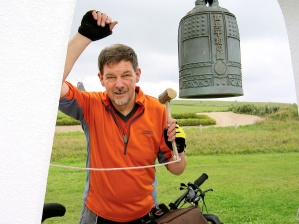
|
|
|
|
Ads by Infohub Partnership with TGCT Mutual Support with JCA |
1. Beginnings - and a World Peace Bell:
Japanese friends told me, "Please be careful when you think about bike riding the length of Japan. Our roads are too busy. Our country has too many mountains." In their typically polite Japanese way they were advising me not to do it. Maybe they thought, at age 60, I was just too old? But I had to agree, compared with many other countries, Japan offered very little information for visiting cyclists. Where were the guide books - even maps I could read? The unknowns were part of the attraction. I am not good at following a guide book anyway. I have always loved maps and planning my own journey. Surfing the Net I discovered Japan Cycling Navigator. JCN confirmed my intended adventure was achievable. And JCN introduced the English edition of Shobunsha's Road Atlas Japan.
To cast his bell Mr Nakagawa had canvassed 65 member countries of the (then) new United Nations asking for their donations of meltable coins. His private mission was to say that no nation should experience an atomic bomb attack as his country did in August 1945. Known as the World Peace Bell, it was located in the inner court of the United Nations headquarters in New York. To this day it is supported on soil from Hiroshima and Nagasaki. Twenty replicas of the original bell have since been gifted through 16 countries. As with the original, replicas are cast from the coins of United Nations member countries. One is in Australia - in Cowra, a rural New South Wales town. It was gifted in 1990 to commemorate a remarkable friendship between Australians and Japanese in the aftermath of a wartime tragedy. I visited Cowra one October to write about the annual Sakura Matsuri. (On August 5, 1944 over 1100 Japanese escaped from the Cowra POW camp. More than 200 Japanese were killed by Australian gunfire. Japanese killed four Australian soldiers.) Another replica bell is on a rise overlooking Soya misaki, the northernmost tip of Hokkaido, Japan. Accompanied by my Japanese partner, Haruko, I had travelled to Soya in January 2001, riding in a small motor train that carved its tracks from the snow. Soya, 27 kilometres from Japan's most northern rail terminal, was a mere 43 kilometres from Siberia. Daytime temperatures hovered around minus 22 degrees Celsius. Ice floated on the sea. Soya was my kind of place. (The winter journey inspired a newspaper story Slow Tracks to Wakkanai which caught the attention of the World Peace Bell Association in Tokyo. I said I would ride my bicycle the length of Japan if the WPBA would agree to gift a World Peace Bell to New Zealand.) [Contents] [2. Return to Soya - the Hokkaido journey:] uploaded:20, 08, 2006
|
|
|
|
Copyright "Japan Cycling Navigator". All
rights reserved.
|


 I had also been fascinated by the story of Chiyoji Nakagawa, a one-time Mayor of Uwajima in Shikoku who, in 1954, presented a huge bell as a token of peace to the United Nations. The bell was similar to any large temple bell found throughout Japan, but with one important difference.
I had also been fascinated by the story of Chiyoji Nakagawa, a one-time Mayor of Uwajima in Shikoku who, in 1954, presented a huge bell as a token of peace to the United Nations. The bell was similar to any large temple bell found throughout Japan, but with one important difference.
